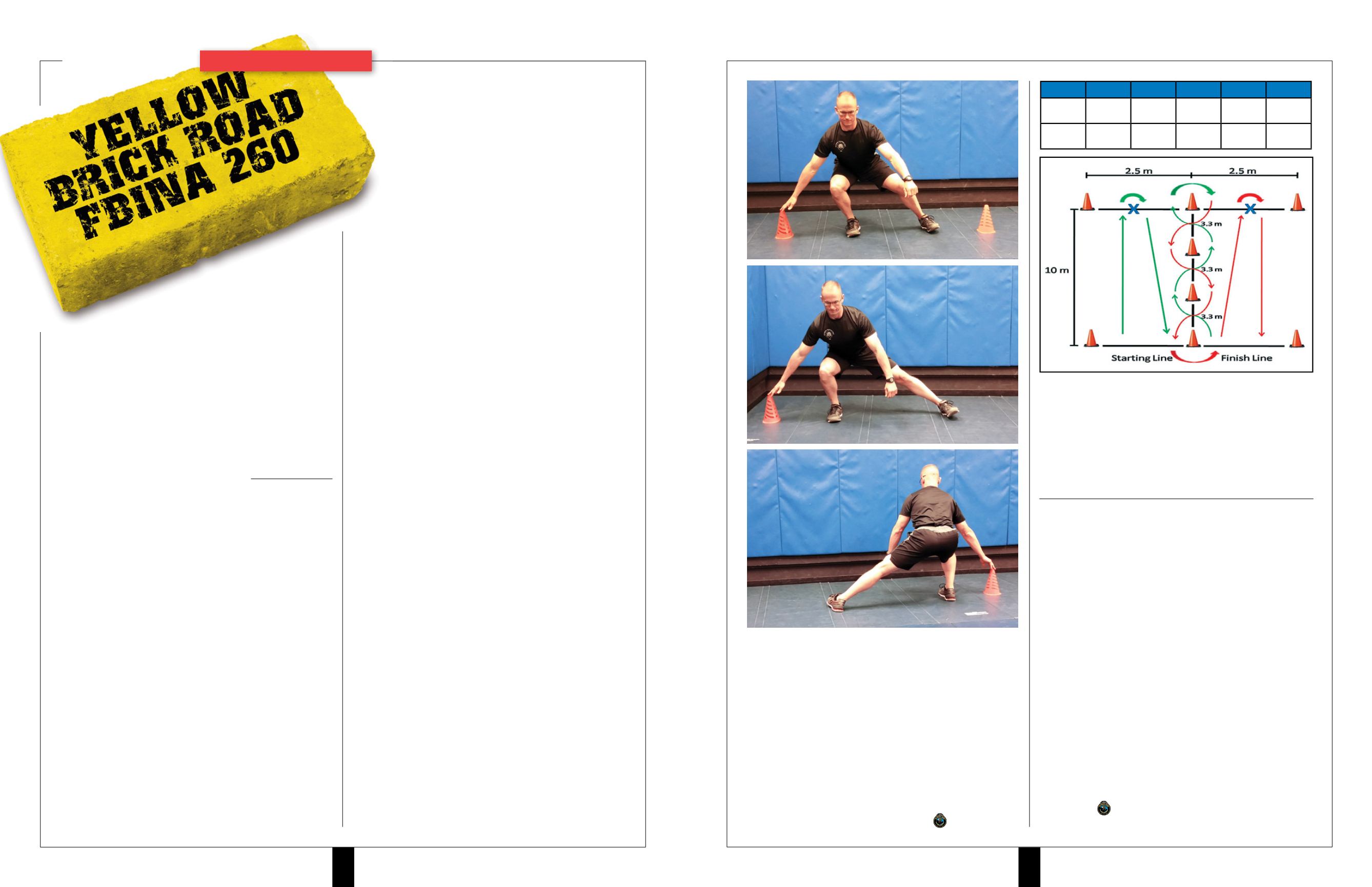

20
www.fbinaa.org21
M AY
2 0 1 5
J U N
1. Can you decelerate? Eccentric strength is the ability to put
on the brakes.
2. Can you restart movement quickly after to you stop?
Can you put force into the ground?
3. Can you take off and land with stability?
Unlike endurance running or linear speed work, keep your
feet low to the ground for quick and accurate strides. Gam-
betta also points out that true agility has cognitive component.
In addition to possessing the critical movement skills, your
perception and decision making skills will heavily influence
your multi-directional speed. Once you posses the motor skills
to stop and start efficiently, introduce a reactivity component
such as auditory, visual and/or tactile cues. Rather than simply running
around the same set of cones, have training partners call out directions,
flash signs or touch a side of the body to influence the next change of
direction. This will provide endless variations and maximize your training.
Training for Agility
Once you’ve established or re-established the required motor abilities for
agility training, here is a progression for improving your change-of-direction:
“Wheel” Drill
From a stationary start, imagine you are in the center of a wheel and
all of the spokes represent the potential directions or planes of mo-
tion (moving forward, laterally and to the rear). Drive out aggressively
out in the direction of the desired spoke using a three-step sequence
of “left-right-left” and “right-left-right”. On the third step, “stick” the
landing with your foot flat on the ground and your shin perpendicular
to the floor. Hold for a solid one count before stepping back to the
starting position. Remember to work your way through every spoke in
the wheel. Adding steps increases the braking demands, and you can
begin the drill with a rolling start. For operational readiness, try starting
from a seated position.
“Sway” Drill
Place two cones (or red solo cups, if you prefer) approximately 6 feet
apart and stand in the middle. Squat down while keeping your chest up
and “sway” back and forth towards the cones on either side. The goal
is to not to see how far you can stretch your arms, but rather how well
you can project your hips laterally over your foot
(Figure 1)
. Gradually
increase distance between the cones and widen your feet while focusing
on projecting your hips outside of your base of support. As the cones or
cups widen, speed up the drill by adding a lateral step out to touch the
cone and back
(Figure 2)
. With one foot anchored in the middle, take a
lateral step to one side and then take a powerful pivot step finishing all
the way on the other side
(Figure 3)
.
“Curve” Drills
Curved runs are a great way to introduce gradual change of directions
and shifting your center of gravity outside of your base of support. Start
with a “lazy S” or serpentine pattern and gradually tighten the course
with sharper cuts. Progress to a large “figure 8” pattern and progressive-
ly shorten the course. Eventually, add full “circle” patterns in clockwise
and counterclockwise directions.
Agility training sessions should be characterized by short, intense
bursts of quick and accurate changes in direction, with fairly long and
complete rest or recovery periods. Overall, the training volume should
start small and build slowly over time. Training for agility when fatigued
Running Better
Would be Better
– PART TWO
M AY
2 0 1 5
J U N
STAYING ON THE
YELLOW BRICK ROAD
I
n Part One, I introduced the idea that running as a skill worthy
of being developed and highlighted the characteristics of efficient
runners. Those techniques were geared towards endurance running and
might be part of a comprehensive physical training program to enhance
cardiorespiratory endurance while avoiding common running injuries.
Endurance running is fine, but speed is the difference maker. In this ar-
ticle, I’d like to cover the fundamentals of agility, or speed while rapidly
changing directions in all planes of motion with excellent body control.
Law enforcement officers who train and improve their agility will be
able to quickly get into and out of positions that might have otherwise
been impossible. This has major implications for officer safety as well as
improved job performance. It can also add a nice punch of variety to a
stagnate program.
In Vern Gambetta’s
Athletic Development
, he defines agility as “the
ability to change the direction or orientation of the body based on inter-
nal or external information without a significant loss of speed”. There-
fore, agility requires a combination of dynamic balance, coordination,
power and speed. In other words, you can’t effectively train for agility
if you haven’t developed those critical components. If you’re not sure,
answer the following questions from long-time strength and condition-
ing coach Mike Boyle:
and before technique is perfected is a recipe for compromised movement
patterns and injury. Build the quality, and then build the capacity!
Testing Agility
The Illinios Agility Test, used in some law enforcement physical ability
tests, is a good example of assessing movement speed with multiple
changes in direction and orientation of the body. The test begins with
the participant lying prone on the floor behind the starting line with
their arms at their side and head facing forward (or turned to the side).
On the command “go”, the participant quickly pops up and moves
forward around a cone or mark at the far line and returns to the first
of four center cones. The participant then quickly weaves up and back
through the center cones, and then quickly moves to other cone or
mark at the far line. After rounding that cone or mark, the participant
runs across the finish line as quickly as possible.
References:
Boyle, Michael.
Functional Training for Sports.
Human Kinetics, 2004.
Gambetta, Vern.
Athletic Development: The Art & Science of Functional Sports Conditioning
.
Human Kinetics, 2007.
About the Author:
John G. Van Vorst
is a Health & Fitness Instructor within the Physical
Training Unit at the FBI Academy. He holds a master’s degree in exercise physiology and is
certified by the American College of Sports Medicine, the National Academy of Sports Med-
icine and the National Strength and Conditioning Association. He also serves as a defensive
tactics instructor for the FBI New Agents Training program.
John.vanvorst@ic.fbi.gov.
www.fbinaa.orgJohn Van Vorst
Staying on the Yellow Brick Road
continued from page 20
The Historian’s Spotlight
continued from page 19
continued on page 21
“In skating over thin ice, our safety
is in our speed.”
– RalphWaldo Emerson
GENDER EXCELLENT ABOVE AVG AVERAGE BELOW AVG POOR
MALE <15.2 secs 15.2-16.1
secs
16.2-18.1
secs
18.2-19.3
secs
>19.3 secs
FEMALE <17.0 secs 17.0-17.9
secs
18.0-21.7
secs
21.8-23.0
secs
>23.0 secs
Figure 1
Figure 2
Figure 3
Figure 4: The Illinois Agility Test
his Chief had recommended that he take the course he had little inter-
est in the concept. However since his boss had “suggested’ he take the
class he did so! He ended up bringing several programs back to his
agency including the citizen police academy. He learned that he was a
believer in the philosophy of community policing without knowing it!
Clayton fulfilled his goal of becoming Ponca City Police Chief in No-
vember of 2002. This came after serving in both patrol and investigations
and being promoted up through the ranks. He stayed in that position until
August 2011 when he fulfilled another goal of becoming US Marshal.
If you read the resume of Clayton Johnson you would immedi-
ately notice that he is a man who has given much to his community
and the law enforcement profession. His list of awards and accomplish-
ments are many and varied and include being President of the Okla-
homa FBINAA Chapter in 2005. Marshal Clayton Johnson is typical
of most FBI National Academy graduates who daily serve and protect
our great nation and continually strive to improve their professional-
ism so they can serve even better.
If you know of a distinguished NA grad in your area who you
feel deserves recognition please contact me by cell
540.810.2721
or by
email at
Terrylucasfbinaa@gmail.com .Thanks for all you do and stay
safe out there.
Terry Lucas
FBINAA National Historian, NA Session 182

















